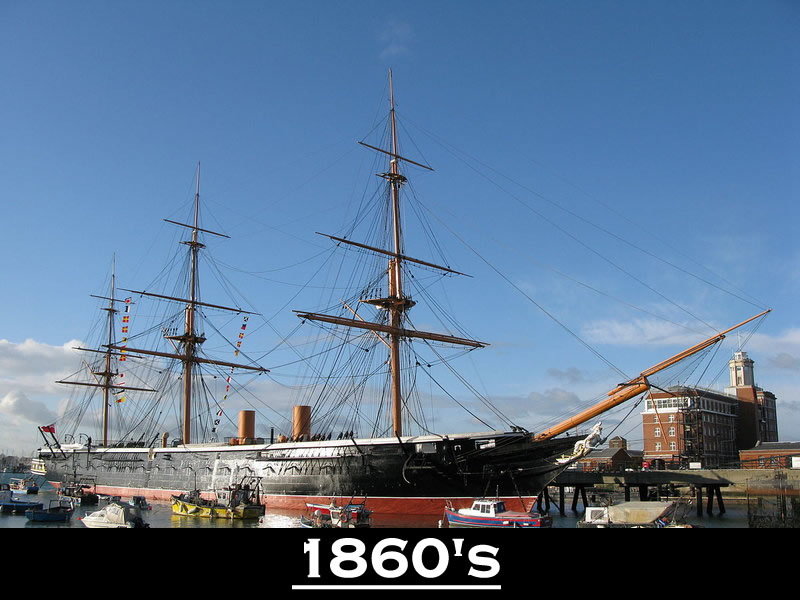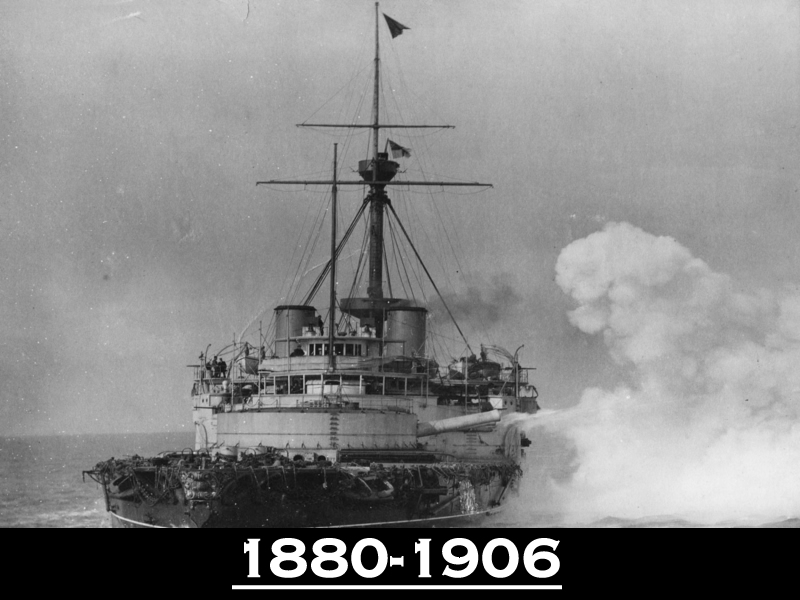


The ironclad was a an early battleship. These ships where an evolution of the wooden ship of the line. They came about as a response too the appearance of incendiary rounds in the early 19th century, which rendered all wooden ships obsolete. Most of the major naval powers recognised this problem. The first battleship to appear that used iron cladding was the French navy's FS Glorie. This was a 78.22m vessel with a displacement of 5,618 tons. The ship, as would most ironclads, still followed the basic premise of the old sailing ships. The main battery was arranged on the side of the ship, not in turrets. Furthermore, most of the time the ships used sails for strategic deployment. Only using steam power when taticaly advantageous. This was due in part to the lack of coaling stations, but also due to the lower power output and reliability issues of the early steam engines. FS Glorie was ironclad in the truest sense, she had a wooden frame with 4.7” (120mm) armour plates added to the sides. Even this small amount of armour was able to stop penetrations of the ships citadel by both the French 50-pounder and the British 68 pounder. Two of the most powerful guns of the time. The Glorie set the basic premise for the ships of the time. She was countered by the British HMS Warrior (shown in the image above). Warrior was designed to be the most powerful ship afloat at launch. She was of all iron construction. With a 4.5” (114mm) main armour belt. She had a steam engine giving 5,772hp allowing here to make 14 knots in good conditions. The total displacement is 9,137 tons, this made her nearly twice the size of Glorie. She was also armed with a heavy armament, including new breech-loading rifled naval guns. This allowed for greater penetration characteristics. Warrior and Glorie started a naval arms race, where in as soon as a ship was launched it might well be obsolete. This race would continue all the way up until the first naval treaty in 1922.

Pre-Dreadnoughts follow on from the ironclads before them. As steam engines became more reliable, and more coaling stations opened up around the world, battleships did not need to use wind power to get to there destinations. The first battleship to do away with rigging completely was the HMS Devastation launched. This ship was still an ironclad, but it is starting to show the key features of a pre-dreadnought. Namely, the use of several different gun calibres. The use of a turret and the use of a powerful triple expansion steam engine. But she still used wrought iron as her main armour. The use of steel armour became more common as armour piercing shells emerged. Firstly in the form of compound armour. This used a steel plate , backed by wrought iron. In theory, the front plate would break up the shell and the iron plate would catch splinters. Within 20 years this process was obsolete and replaced by the Harvey Process. This used a single plate of steel, but with the front surface of the steel plate face hardened. This allowed the steel plate to have the advantages of compound armour with less weight. One of the best examples of the pre-dreadnought era is the HMS Majestic. Launched in 1895 she had 9” of Harvey steel. Along with a main armament consisting of 4 x 12” guns in twin mountings and twelve 6-inch guns. Overall, nine ships of this class where produced. The main area in which pre-dreadnoughts differ from dreadnoughts is in main armament and fire control. Pre dreadnoughts tend to have a mixed main armament of different gun calibres with no central range finding. This lead to issues with aiming salvoes as each gun has different aiming characteristics. The main highlight of this period is the Battle of Tsushima in the Russo-Japanese war of 1904. This battle included pre-dreadnoughts of both sides, including the IJN Mikasa, now a museum ship. Other naval power watched this battle closely. It showed the major short comings of current ship design. Mainly the fire control issues mentioned previously. It also showed the rise of Japan to the level of a great naval power.

HMS Dreadnought was launched 10 of February 1906. Upon doing so, every other battleship afloat was made obsolete. So much so, that battleships launched previously where renamed pre-dreadnoughts. Her main feature was her 10 x 12” guns, which where aimed and fired by a central range finder. This lead to much better accuracy at range. It also meant she had a very large punch. She was also very fast for he size. Using newly developed steam turbines in order to produce 23,000hp. This allowed her to make 21 knots. She also had an 11inch belt using the new Krupp steel process which replaced the Harvey process. This ship had a number of geo-political effects. Firstly, it levelled the playing field in terms ship numbers. The British navy had a very large number advantage in terms of pre-dreadnoughts. But, the launch of Dreadnought made there own fleet as obsolete as everyone else. This meant that the other naval powesr felt a chance to catch up and over take the Royal Navy in terms of capital ships. This sparked the Anglo-German naval arms race. Another development related to the dreadnought to come out of this period was the creation of the Battlecruiser. This was a vessel designed to carry battleship level weaponry but on a lightly armoured hull. This allowed for it to have greater speed. It's main aim was to be a cruiser hunter, and not for use in the line of battle like a normal Dreadnought. The battle cruiser was found to be a flawed concept due to misuse during WW1. The development of Dreadnoughts was rapid for instance. The first German dreadnought launched in 1907 , SMS Nassau, displaced just over 20,500 tons. By 1913 the SMS Bayern displaced 32,000 tons. The largest naval battle in history happened during this era. The Battle of Jutland during World War 1 occured bettween the British Grand Fleet and the German High Seas Fleet. This showed agian where naval technolgoy was heading. For instance, the use of these large guns and more accurate fire control systems lead to a larger combat range than expected. This lead to ships experienceing more plunging fire than expected. By World War 2, this would be an issue that required major consideration, whith ships needing more deck armour.

test4

test5